![]()
CHAPTER FIVE
DEVELOP NEW SKILLS AND KNOWLEDGE
As Chloe walked into our local wine bar, there was a sparkle in her eyes and a huge smile on her face. Well rested from her week in Arizona over spring break and just back from a trip to New York with the CEO of the company where she has worked for 20 years, she was energized and excited when she sat down at our favorite high-top table. As a managing partner at one of the largest financial services firms, back-to-back meetings, numerous deadlines, a full to-do list, and high stress were part of her job description. However, I rarely heard Chloe complain about her work, and she appeared happy, engaged, and professionally fulfilled.
After our glasses of sauvignon blanc and our bowl of roasted nuts arrived, I jumped right in. “I’ve been spending a lot of time with clients who are unhappy, demotivated, and unfulfilled at work. And I’m meeting more and more people across the country who dread Monday mornings. This does not appear to be you. How do you do it? What is your secret?”
Chloe said, “I think it’s a combination of a few things, actually. From an early age I was fascinated by business. At 15, I was reading Fortune, Forbes, and BusinessWeek.”
Chloe gave me a smile, perhaps because she knew me well enough to know that at 15 I was reading Cosmo and Seventeen and trying to learn how to apply my blue eye shadow so it accented my green eyes. It took me a little bit longer to find my passion.
“I was interested in global financial markets. I was good at math and analyzing data. So when I went to college, I majored in finance,” Chloe added.
“Why did you choose to work for the bank?”
“Well, I chose the bank because it was global, and I could have 20 different careers within one company. This was intriguing to me,” she said. “Our industry is changing so rapidly, I have to continue to develop new expertise to stay current. You know I love to learn!”
Chloe continued. “Did you know that I’ve never applied for a job since I applied the first time?”
“Really? That’s incredible!”
“Every time I’ve accepted a new job it was because someone called me and said I want you to join our group. Why? Because I volunteered for other initiatives in the bank which allowed me to interact with people I would not normally interact with. I built a reputation for achieving results, synthesizing the complex, and successfully navigating a complex organization.”
A few key themes emerged for me as Chloe continued to talk. First, choose an industry that interests you. Second, know your strengths and leverage those strengths in your work. Third, develop yourself. And finally, build relationships and connections throughout your company.
Each of these is an essential step on your transformational journey to love your work and turn any job into your dream job. You’ve already unleashed your superpowers of choice and control, acknowledged your appreciation and recognition needs, and identified your strengths and used them to shape your work in a way that meets both your professional and personal needs and goals. Now let’s follow in Chloe’s footsteps and take the next step: develop yourself. This requires that you acquire new capabilities and knowledge and find ways to advance in your career. You chose to invest in yourself, and it’s an investment that pays off—in increased confidence, additional opportunities for a promotion or a raise, enhanced value to your team and company, and more time and energy for the people, hobbies, and projects that interest you. Professional growth and development enable you to stay agile, excited, passionate, and engaged in your job. Assess your current skills and knowledge to create your own professional development plan.
CREATE YOUR ABILITIES OPPORTUNITY MAP
To develop new capabilities and expertise, you need to assess your current skills. This following process will help you easily identify your ability gaps and the new competencies and experiences you need to be enthusiastic and content in your work.
Let’s create your Abilities Opportunity Map. It is a chart of the aptitudes and capabilities you want to cultivate. To download a blank Abilities Opportunity Map, go to www.carsontate.com/dreamjob. (There is also a blank Abilities Opportunity Map in Appendix 2 in the back of this book.)
Step 1. Assess Your Current Skills
The first step in this process is to assess your current skills. Read each statement below and check if the statement is true or false for you.
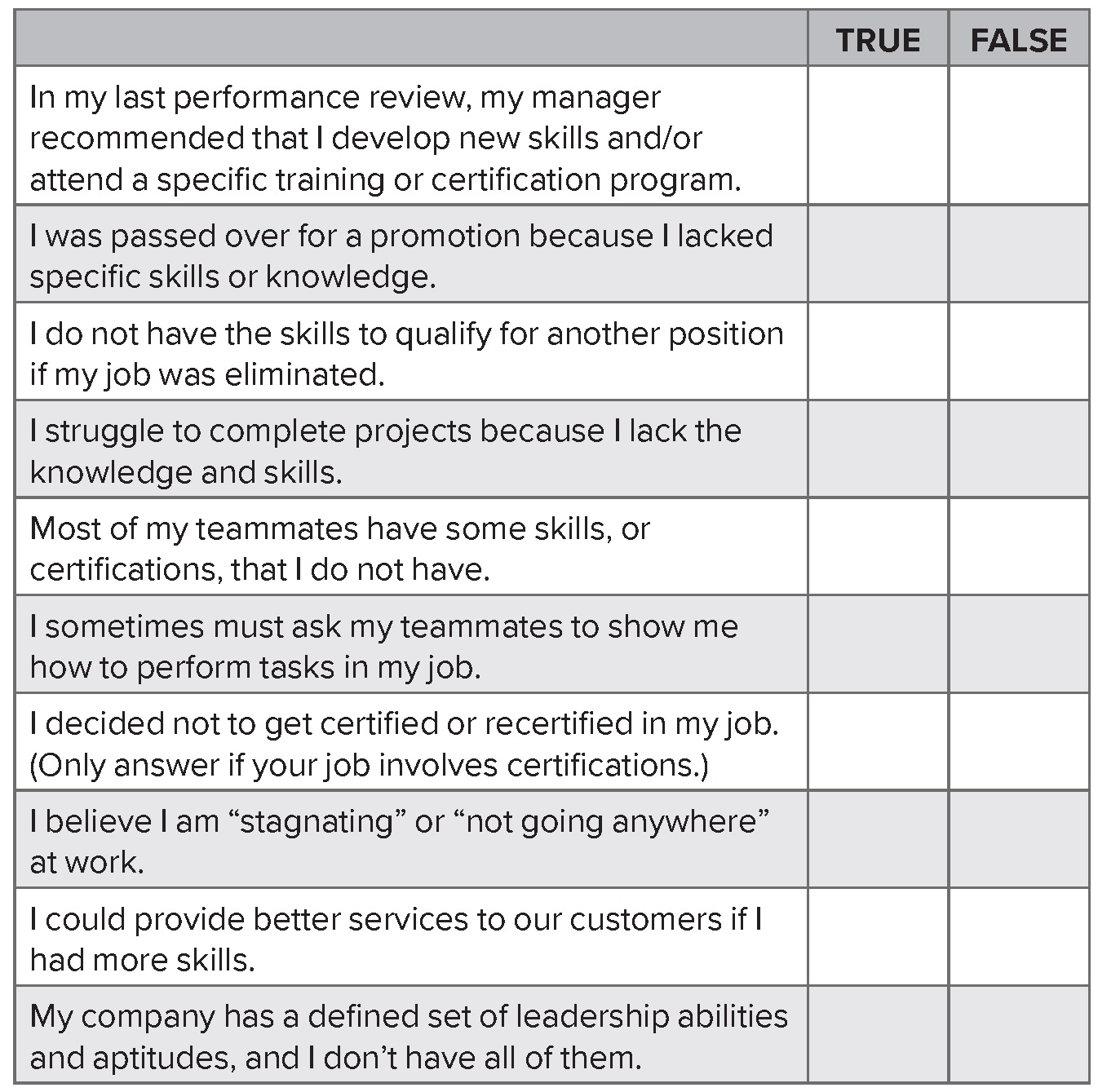
Review the questions that you marked true. These highlight where you need to focus your attention to identify the specific skill set you need and want to develop in your job. This is not a list of your inadequacies, imperfections, or failings. Each true statement is a place on your Abilities Opportunity Map that you choose to visit, explore, and learn more about. These true statements can be considered a “skill set destination” on your professional development journey.
If you’re like most of my clients, you probably have heard the term “skill set” so often you haven’t really thought about what it actually means in quite a while. I think it’s important to revisit the meaning. A skill set is a collection of abilities, qualities, and experiences you have and can apply.
There are three types of skill sets: soft skills, hard skills, and hybrid skills.
• Soft skills are interpersonal abilities you use to interact with other people. For example, communication, listening, empathy, agility, and teamwork. These skills are transferable and valuable in any job in any industry.
• Hard skills are technical capabilities you use to perform a task related to a specific job. For example, accounting, data analysis, SEO marketing, information technology, or copywriting.
• Hybrid skills are a combination of both soft and hard skills. For example, a customer service representative would need the soft skills of exceptional communication and conflict resolution expertise, as well as the hard skill of proficiency with a customer relationship management software program.
Step 2. Identify the Specific Skills and Expertise You Want to Develop
The second step to construct your Abilities Opportunity Map is to identify and clarify the specific skills and expertise you want and need to develop. This is a critical step. Each aptitude you distinguish is a destination on your Abilities Opportunity Map. It is where you want to go on the journey to develop yourself.
Below you will see all the questions from Step 1. For any that you marked true, answer the corresponding prompts that begin on page 97. This exercise will take you between 30 and 45 minutes to complete. You are worth the time. This is an investment in your professional development, growth, career, and future.
Now, a few of the prompts are basic and probably obvious. This is intentional. It will help you synthesize and organize your thoughts and data. You need specific information to determine exactly what aptitudes and expertise you want to develop. And your answers to the questions will also guide how you will acquire your new skills.
As you answer each of the prompts for each question you marked true, do not worry about the form or structure of your notes and reflections. The objective in this step is simply to collect information. In Step 3 you will review your notes and organize them.
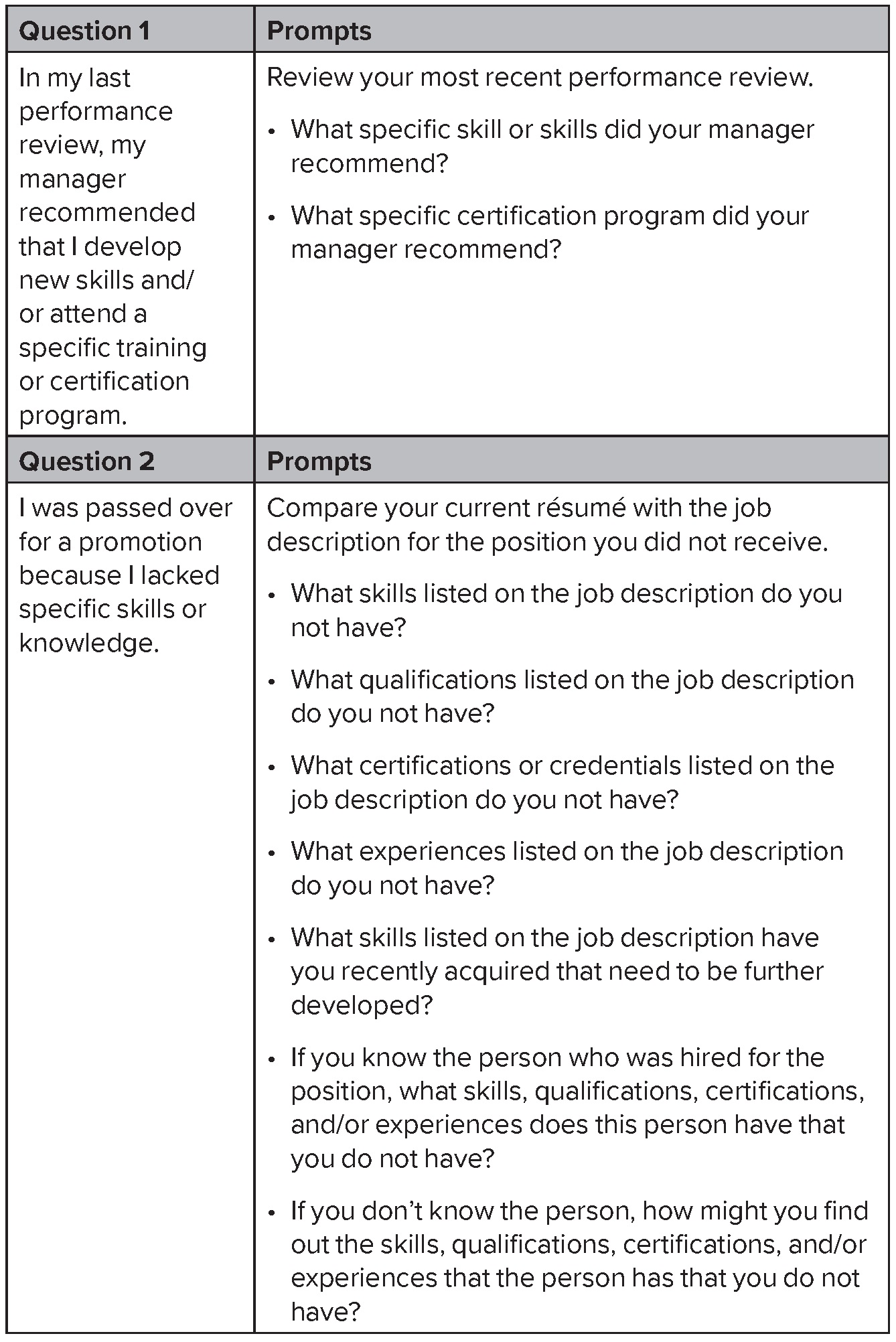

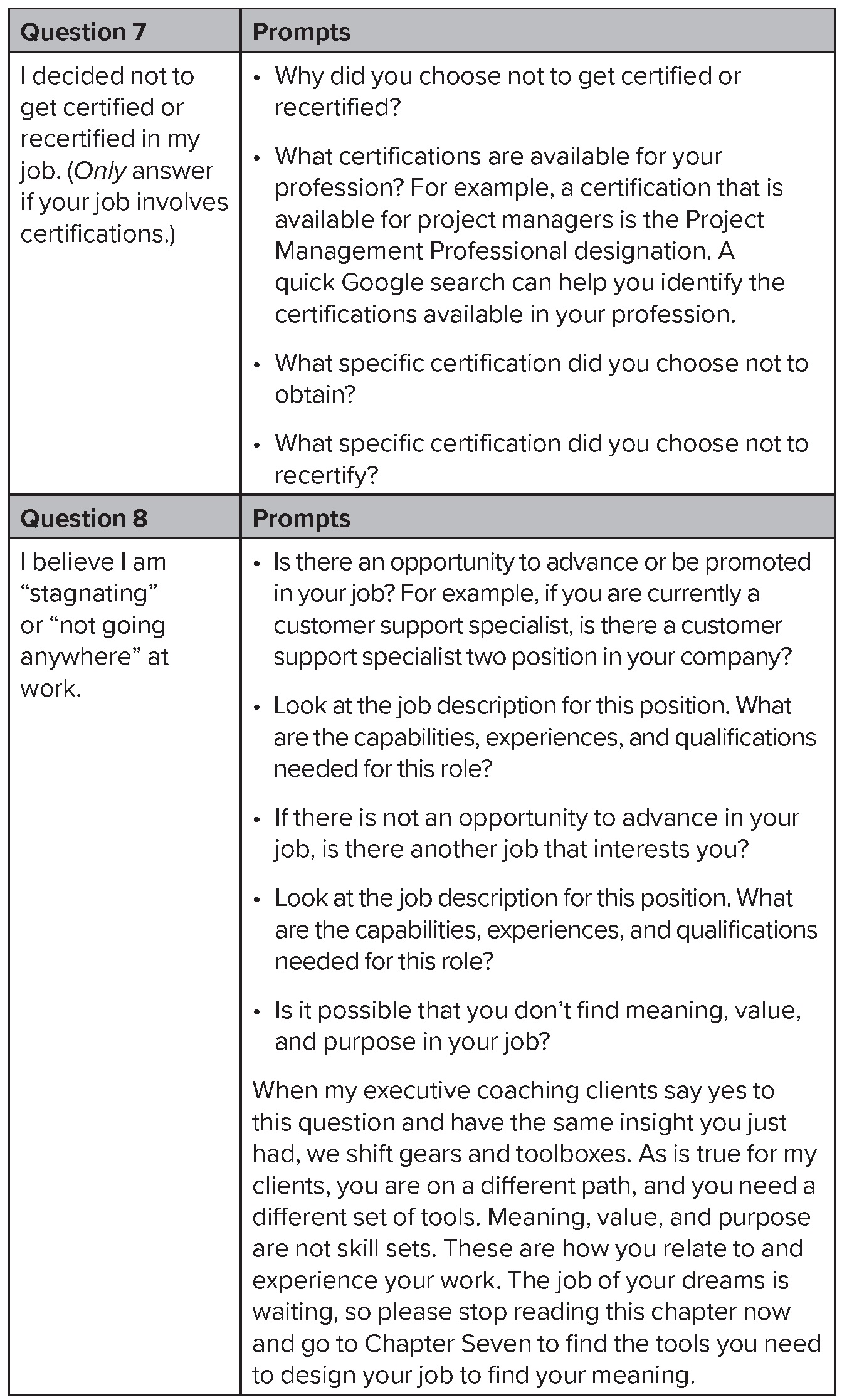

You now have copious notes and data on the specific aptitudes and expertise you want to develop. Take a moment and acknowledge yourself for your commitment to yourself and your professional development. Completing Step 2 is a significant, powerful step. Well done!
If you are like my clients, you may feel overwhelmed right now. I get it. You have pages of notes, data, and documentation, and you may be thinking to yourself, “What am I going to do with all this information?” The answer is it’s time to organize your answers to each prompt by the type of skill set you need to develop to acquire your new knowledge or expertise. Let’s move on to Step 3.
Step 3. Identify the Type of Skill Set You Need to Develop
The third step to build your Abilities Opportunity Map is to identify the type of skill set you need to develop. This is an essential step because it will inform how you will acquire the skill set. On a piece of paper, or on your computer, draw three columns. At the top of the first column write “Soft Skills.” Above the second column write “Hard Skills,” and above the third column write “Hybrid Skills.”
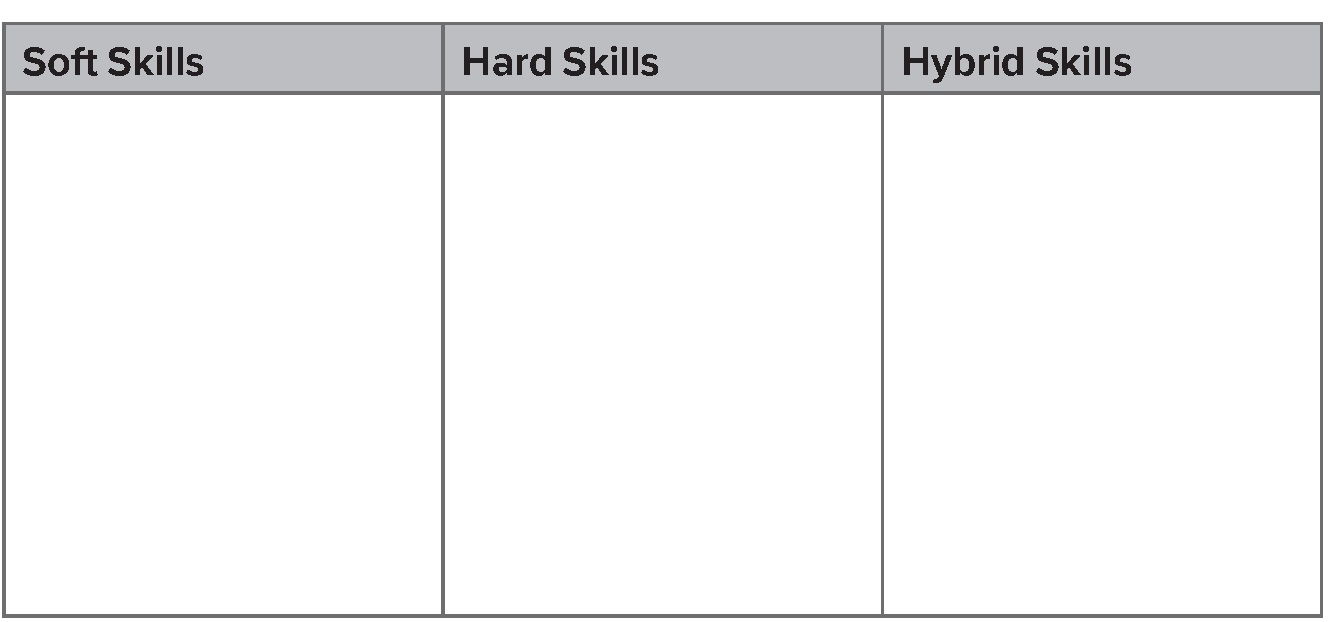
Then return to Step 2 and review your answers to the prompts for each question you marked “true.” As you review each response, write it in either the Soft Skills, Hard Skills, or Hybrid Skills column. An example is included below:
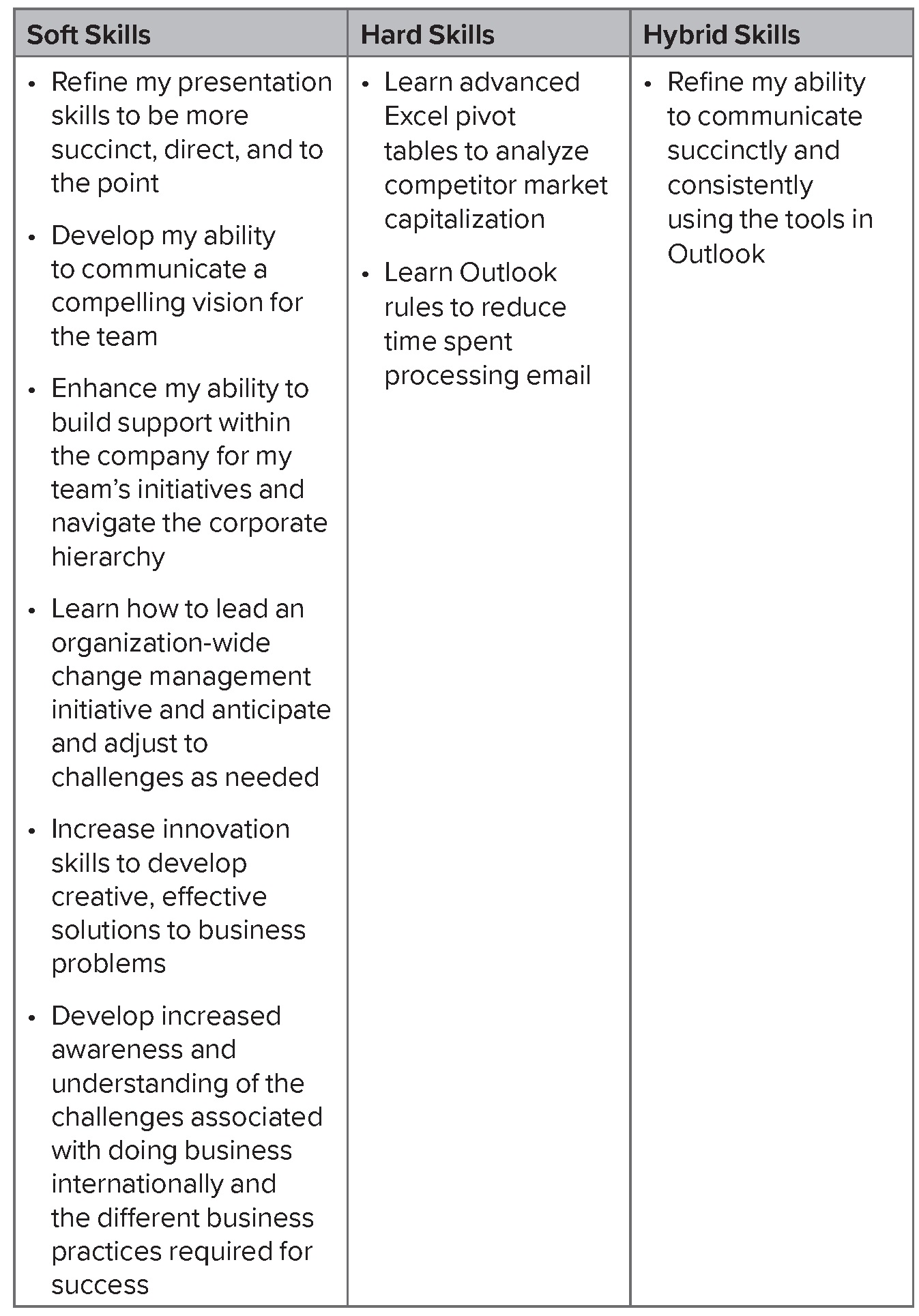
Step 4. Prioritize the Top Three Skills You Want to Develop
You’ve probably heard the Lao-tzu saying, “A journey of 1,000 miles begins with a single step.” This is true for you right now. You have a list of numerous soft, hard, and hybrid skills that you want to develop. The reality is that you can’t do them all right now. However, you are committed to your professional development and advancing your career. Let’s prioritize the top three skills you want to develop in the next 6 to 12 months. Review your list of soft, hard, and hybrid skills and select the three that will enable you to make a significant impact quickly, are directly tied to a professional goal or objective, and/or enable you to distinguish yourself on your team and within your company.
An example is below:
My Top Three Skills to Develop
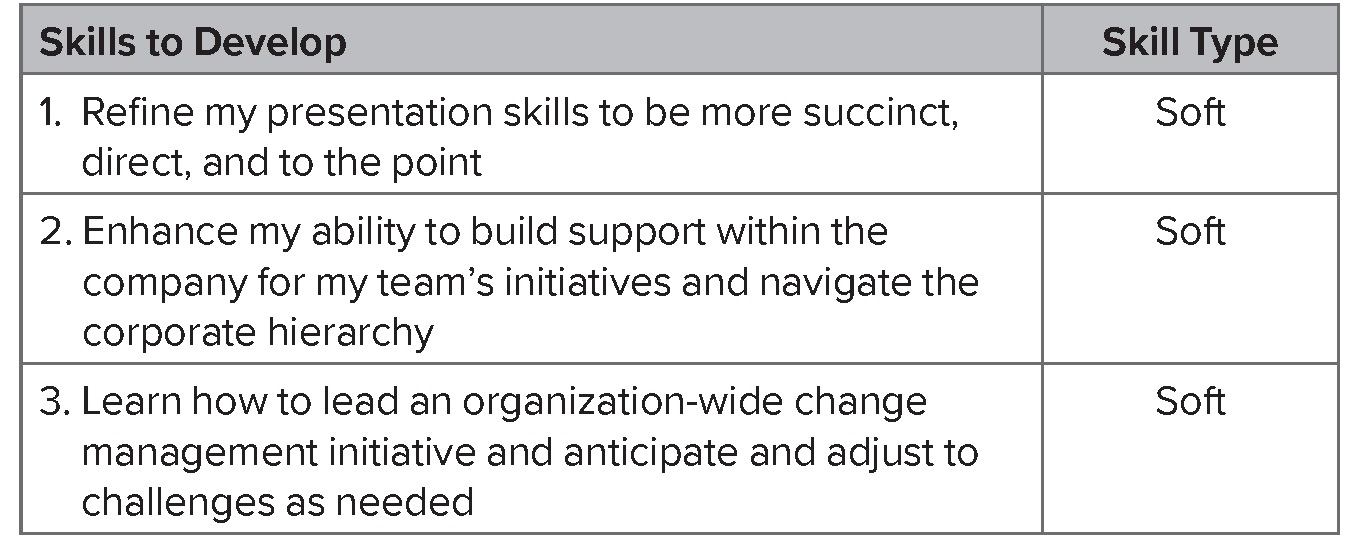
Your Abilities Opportunity Map is almost complete! So far, you have (1) assessed your current skills, (2) identified the specific capabilities and aptitudes you want and need to develop, (3) organized your specific competencies and expertise by type of skill set—soft skill, hard skill, or hybrid skill—and (4) prioritized the top three skills you want to develop. Great work! You have just one final step to complete your map—determine how to acquire your new skills or knowledge.
Step 5. Determine How to Acquire Your New Skills and Knowledge
For each one of your top three skills you chose to develop, determine and write down how you will acquire that new capability or knowledge. You may decide that you want or need to combine one or two of the options to acquire your new skills. That’s fine. This is your professional development plan.
You will need to have your Abilities Opportunity Map next to you as you read the following section.
SKILL DEVELOPMENT OPTIONS
In this section, you will see your development options grouped by skill set: soft skills, hard skills, and hybrid skills. As you read each option, decide if it will enable you to acquire one of your top three skills. If it will, write that option next to the skill in the “How?” column of your Abilities Opportunity Map.
Soft Skill Acquisition Options
Remember, soft skills are interpersonal abilities you use to interact with other people. For example, communication, listening, empathy, agility, and teamwork. Below are some ways that you can acquire soft skills.
Get a Coach
Coaching is an action-oriented, goal-focused process to improve performance, guide self-discovery, and make behavioral shifts. It is future-focused and believes that the individual being coached has the capacity for positive self-actualization.
This is one of the most effective ways to develop soft skills. You work one-on-one with a coach, so you have a safe, nonjudgmental place to practice and receive feedback on the skill(s) you want to develop. This is essential because soft skills, such as active listening or conflict resolution, require a consistent practice-feedback-practice loop to learn. You and your coach meet regularly, which helps you stay accountable and committed to applying your new skills.
Your company may have internal coaches or a relationship with a coaching firm. Contact your human resources department to find a coach at your company. Or you can find an external coach through the International Coach Federation. This is a global organization with over 25,000 professionally trained coaches. On its website, you can search for a coach based on location and/or the specific skill set you want to obtain or improve. We also have a team of certified coaches trained in the strategies and tools in this book.*
Mentoring
Mentoring can be either a formal or an informal learning relationship. A mentor can share technical information, institutional knowledge, insights into your company’s culture or politics, or broad insights about leadership, networking, communication, and teamwork.
Find and develop a relationship with a person who has been in your shoes, is where you want to be in your career, and is willing to give you unvarnished, honest feedback. For example, one of my coaching clients is Jade, a minority female physician in a large healthcare system. She developed a mentoring relationship with another minority female, Prisha, who understood the hospital’s politics, had successfully navigated the patriarchal, white-male culture of the system, and had two high-profile leadership positions in the system. Jade asked for her mentorship so she could refine her own leadership skills and understand how to acquire leadership positions in the healthcare system.
A mentoring relationship is more dynamic and fluid than coaching. You may or may not meet regularly with your mentor. And if you want feedback from your mentor on your soft skills, your mentor must have opportunities to see you use them.
Check with your company’s human resources department to find out if it has a formal mentoring program and, if so, how to get involved. If your company does not have a formal mentoring program, identify the person, as Jade did, who demonstrates the knowledge, skills, or expertise you want to obtain and reach out to that person.
Training Courses
A training course can be an in-person class, a virtual instructor-led class such as a webinar, a self-paced online module, or a combination of these three.
A training curriculum will help you develop soft skills; it is designed to teach you the mechanics of soft skills. For example, in a communications training course you may learn to restate what you heard to show you were actively listening and to enable others to clarify what they said if you’ve misheard or misunderstood them.
It is important to think about how you will practice and receive feedback on the skill(s) you learn in a training class. Depending on the type of program, you may have the opportunity to practice in the class and receive feedback from the instructor. However, to change your current behavior and develop new behavior requires consistent practice and feedback. Solicit your manager, teammates, and/or peers to give you feedback when you practice your new skill(s) in a setting where they can watch you, such as a meeting. Ask them to observe your behavior and then provide feedback immediately after the event. For additional tips on how to ask for feedback, go to page 45.
Now let’s explore the options you have to acquire hard skills.
Hard Skills Acquisition Options
Hard skills are technical capabilities you use to perform a task related to a specific job—for example, accounting, data analysis, SEO marketing, information technology, or copywriting. Below are some ways that you can acquire hard skills.
Training Courses
Training courses are an exceptional way to learn new technical skills. Trainings typically target a specific hard skill or set of hard skills, such as how to use Excel pivot tables or how to use technology to manage your email. For example, you could attend one of our Tame Your Inbox trainings to learn how to write rules, create custom templates, and color-code incoming messages from your manager.* You can find a training curriculum for the specific capabilities you want to develop through your company’s human resources department, through your professional association, by attending conferences, or on the Internet.
Job Shadowing
When you job-shadow, you work with and observe another employee who has demonstrated expertise in the skills, behaviors, and/or competencies you want to acquire. It can involve hands-on training, observation, or a combination of both. You can shadow a person for a few hours, days, or even weeks, depending on the type of skill and knowledge you want to develop. To find a job shadowing opportunity, talk to your manager and/or your human resources department to identify the best person for you to shadow.
Lastly, let’s look at the options you have to acquire hybrid skills.
Hybrid Skills Acquisition Options
Since hybrid skills are a combination of both soft and hard competencies, the first step is to use the development options listed above to identify your best option. Three additional routes can be helpful to identify the proficiencies you may need to advance in your career and how you can obtain them.
Informational Interview
In this type of discussion, you seek out and talk to coworkers, thought leaders, and/or industry experts who have the specific job, career, and/or aptitudes you want to obtain. The objective of the conversation is to understand how they achieved success and got to where they are today. Before you meet with someone, do your research so you can ask specific questions that will support your own professional development.
Below are essential questions to ask to understand how the person you selected to interview achieved success. However, you might find the answers to some of the questions as you complete your interview preparation. Add and remove questions from this list based on your research and your own professional development goals.
• What are one or two things you wish you had known when you started in this profession?
• What, if anything, would you do differently?
• What, if anything, would you do the same way?
• What are the challenges or setbacks you have experienced in your career? How did you overcome them?
• What skills do you use regularly?
• How did you acquire these skills?
• What capability are you currently developing? What prompted you to focus on developing this now?
• Are there any books, magazines, trade publications, websites, or podcasts you recommend?
Peer Relationships
Relationships with people in your industry are essential. These associations enable you to stay current on industry trends, certifications, and competencies and to gain new perspectives and ideas. You can foster connections with people in your industry through networking at conferences, professional association or trade events, or local business events.
Once you develop peer relationships, it is important to nurture them. These relationships are about give-and-take, so remember to proactively add value and support your peers. Proactively reach out to your network and ask questions for advice and feedback to help you advance your career.
Experiential Assignments and Opportunities
Real-life experiences are one of the most powerful and fastest ways to learn and develop new knowledge and competencies. There are two primary ways you can engage in an experience: participate in a task force or take part in action learning. A task force is a group of people who work on a specific project. A task force may also be called a committee or a special project team and typically includes people from different divisions within a company. Action learning is a process that involves a group of people who work on a real and important challenge to the organization, solve that problem by practicing new skills, and then reflect on the experience in order to learn and grow from the experience.
Either of these opportunities enables you to practice new skills and observe others in real situations. You can observe how others lead through conflict, how they make decisions, how they navigate company politics and achieve goals. To find a task force or an action learning opportunity, talk to your manager, your human resources department, or your mentor. You may also have the opportunity to participate in action learning if you are part of a leadership development program at your company.
Congratulations! Your Abilities Opportunity Map is complete!
An example of a completed Abilities Opportunity Map is below:
My Top Three Skills to Develop
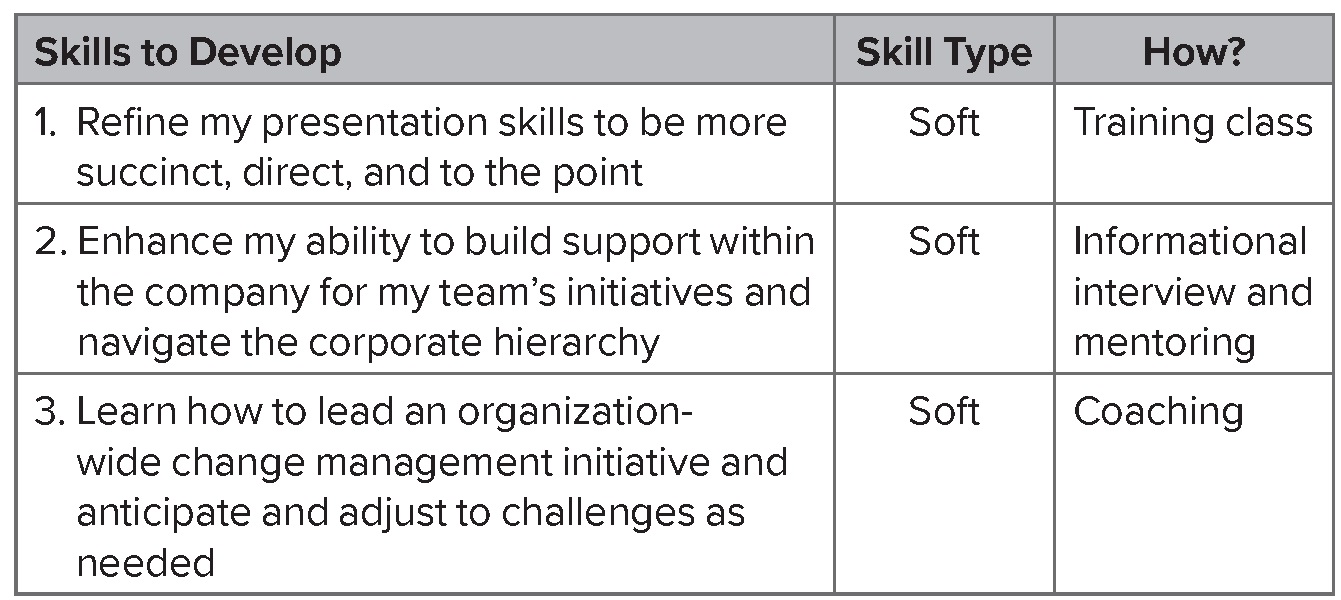
CREATE YOUR PROFESSIONAL DEVELOPMENT PLAN
Now that you have your own Abilities Opportunity Map, you need to select the specific coach, mentor, training program, job shadowing opportunity, informational interview, peer networking opportunity, and/or experience that will enable you to acquire each of your top three development skills. There are a vast variety of professional development options available to you. It can be overwhelming. To narrow down the plethora of options, you will use three words to guide the assessment and selection process—equip, empower, and inspire. These three words make up the mission statement for my company, Working Simply. It is the essence of what we do and how we best serve our clients. And I’d like to suggest you use the same words to serve yourself.
The approach you will use below will help you assess the immense array of available professional development options so you can select the best one for you. This approach has been field-tested and proved with our clients and all our internal training, consulting, and coaching programs.
Start with the first skill you want to develop and how you decided to acquire it. For example, the first skill on the example Abilities Opportunity Map is “Refine my presentation skills to be more succinct, direct, and to the point.” You decided to develop this skill through training. As you review the presentation skills training options you found on the Internet, on your company’s learning management system, or on your professional association’s website, ask yourself the questions beneath “Equip,” “Empower,” and “Inspire” below for each of the three skills you have chosen to develop. (Some of the questions refer specifically to coaching or training. If this is not an option you are evaluating, skip those questions. Or if there is a question that does not apply to the skill acquisition methodology you selected, skip it.)
Equip:
• Will this _____________ equip me with the skills I want and need for my professional development and growth?
• What specific skills does the training course teach?
• What are the learning objectives for the training course?
• What is the coach’s area of expertise and experience?
• Is this person proficient in the use of the skills I want to acquire? Does this person have a demonstrated track record of success?
Empower:
• Will this _____________ empower me and prepare me to apply and integrate my new capabilities and expertise into my workday, life, and/or career?
• What job aid or quick reference guides are provided in the training class?
• What case studies are used to illustrate how to apply the concepts taught in the training curriculum?
• What opportunities do I have to practice and apply the skill during this _____________?
• How does this _____________ prepare me for the challenges I will encounter when I apply and integrate this new skill into my workday, life, and/or career?
Inspire:
• How will this _____________ motivate and inspire me when I hit a challenge or roadblock when I apply my new skills?
• What tools and strategies does this _____________ include to help me develop new, sustainable habits?
• “What ongoing support does this _____________ provide?
There is no one-size-fits-all nor “right” or “wrong” professional development program. Select the plan and/or people who will equip, empower, and inspire you so you can turn any job into your dream job.
![]()
As Chloe and I neared the end of our glasses of wine, I asked her a question I thought I knew the answer to, but I wanted to write her answer down in her own words.
“What is your most significant professional accomplishment?” I asked.
Smiling broadly, Chloe told me, “As you probably guessed, my most significant professional accomplishment ocurred within the last year. After 18 years as the CFO of various business lines within the bank, I now lead our global banking and digital strategy division. I’m on the front line, and my global responsibilities generate more than one billion in annual revenue.”
“You have watched me through the years learn new skills,” she continued. “Remember when I transitioned into mobile banking and had never worked in technology? And how I had to take the monthlong training class on our mobile banking software? That was a very long month. And remember when I went to Switzerland and presented on credit risk after identifying I could use this knowledge to help the bank build its brand as a thought leader in credit risk mitigation?”
“Oh yes! I remember both of those! I am very proud of you and all that you have accomplished in your career,” I said.
We drank our last sip of wine, paid the bill, and walked out to our cars.
You can feel about your career the way Chloe feels about hers. You are ready to develop new skills and knowledge and advance your career so you can turn any job into your dream job. If I gave you a magic wand that transported you into the future and asked you the same question I asked Chloe—“What is your most significant professional accomplishment?”—what would you tell me? Use your Abilities Opportunity Map to make your goals and dreams a reality.
* Sometimes it is easier to do this work with the help of a coach. If you’d like to meet with one of the Working Simply certified coaches to help you own, love, and make your job work for you, visit www.carsontate.com/coaching to learn more.
* My company, Working Simply, offers training programs designed to help you develop the soft, hard, and hybrid skills you need to achieve your career goals and enjoy an engaged and fulfilled work life. Visit www.workingsimply.com to learn more.
